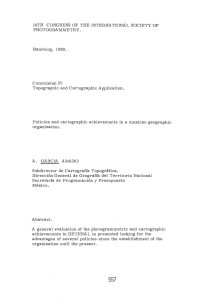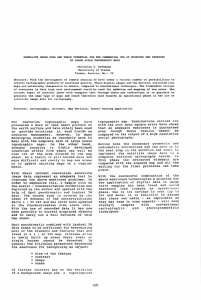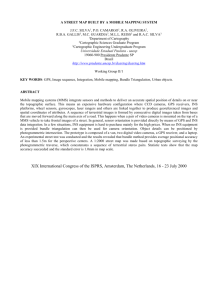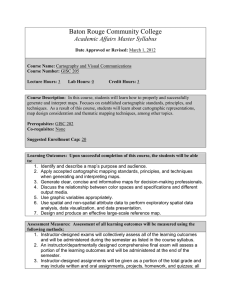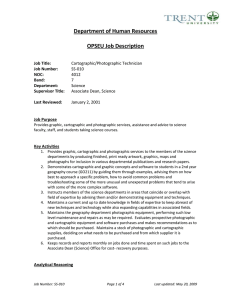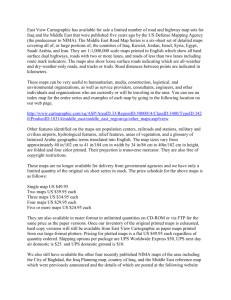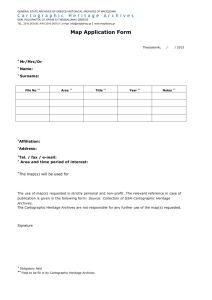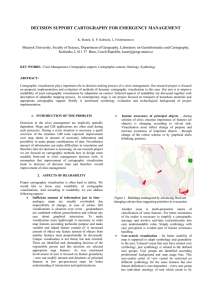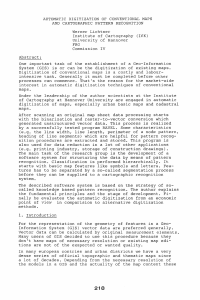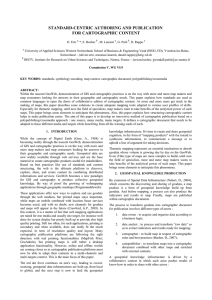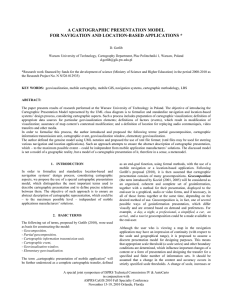standard Procedure and Data Format ... Minoru AKIYAMA, Naoki TAKAYAMA, Shouji ...
advertisement
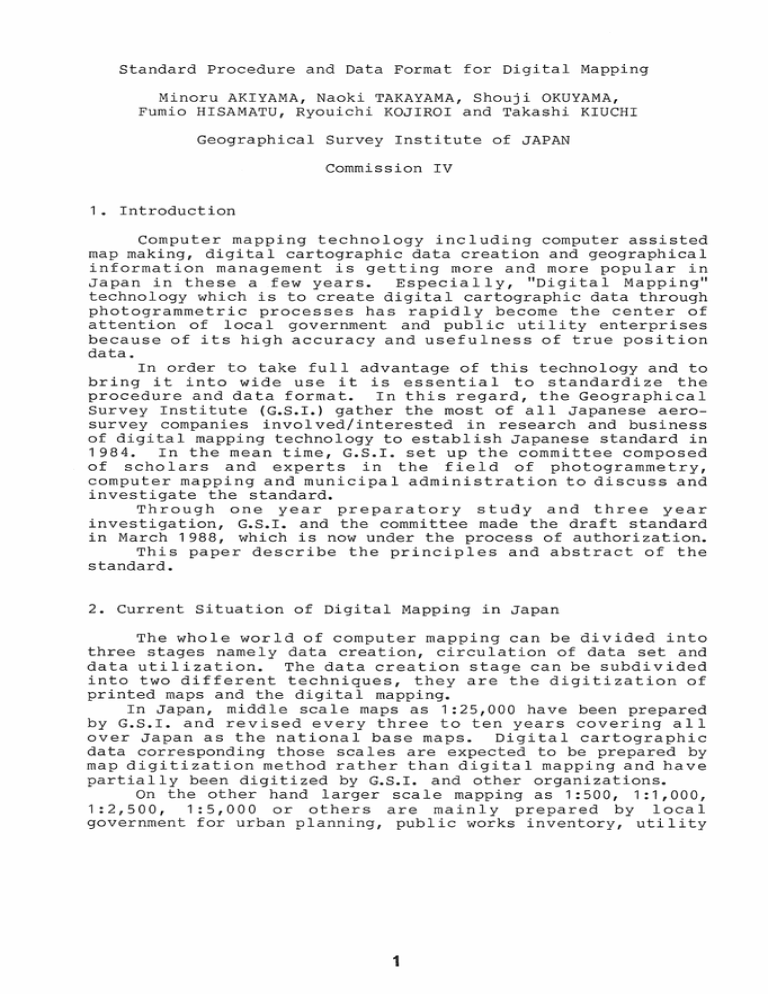
standard Procedure and Data Format for Digital Mapping Minoru AKIYAMA, Naoki TAKAYAMA, Shouji OKUYAMA, Fumio HISAMATU, Ryouichi KOJIROI and Takashi KIUCHI Geographical Survey Institute of JAPAN Commission IV 1 .. Introduction Computer mapping technology including computer assisted map making, digital cartographic data creation and geographical information management is getting more and more popular in Japan in these a few years. Especially, "Digital Mapping" technology which is to create digital cartographic data through photogrammetric processes has rapidly become the center of attention of local government and public utility enterprises because of its high accuracy and usefulness of true position data. In order to take full advantage of this technology and to bring it into wide use it is essential to standardize the procedure and data format. In this regard, the Geographical Survey Institute (G.S.I.) gather the most of all Japanese aerosurvey companies involved/interested in research and business of digital mapping technology to establish Japanese standard in 1984. In the mean time, G.S.I. set up the committee composed of scholars and experts in the field of photogrammetry, computer mapping and municipal administration to discuss and investigate the standard. Through one year preparatory study and three year investigation, G.S.I. and the committee made the draft standard in March 1988, which is now under the process of authorization. This paper describe the principles and abstract of the standard. 2. Current Situation of Digital Mapping in Japan The whole world of computer mapping can be divided into three stages namely data creation, circulation of data set and data utilization. The data creation stage can be subdivided into two different techniques, they are the digitization of printed maps and the digital mapping. In Japan, middle scale maps as 1:25,000 have been prepared by G.S.I. and revised every three to ten years covering all over Japan as the national base maps. Digital cartographic data corresponding those scales are expected to be prepared by map digitization method rather than digital mapping and have partially been digitized by G.S.I. and other organizations. On the other hand larger scale mapping as 1:500, 1:1,000, 1 :2,500, 1 :5,000 or others are mainly prepared by local government for urban planning, public works inventory, utility 1 management and so on. Digitization of those maps are much focused on geographical information system. Because of the requirement of high accuracy and data freshness, digital mapping technology are supposed to be much suitable to the creation of digital cartographic data for those scales. The procedure and specification of digital mapping should be standardized in order to guarantee data accuracy and compatibility so that the data can be utilized by other parties as well. The GeS .. I .. considered that it is our responsibility to help digital mapping community establishing the Japanese standard for the procedure and compatible data format. Before we started this study, some municipalities and public utility enterprises together with some leading aerosurvey companies have prepared digital cartographic data with no compatibility, and this situation has looked expanding year by year. Therefore, in consideration of this urgent, the first draft was issued in March 1986 and the final draft was made in March 1 988 .. 3. Principles of the Standard Digital mapping technology is not only a method to create digital cartographic data but also a photogrammetric surveying and mapping. In this regard, the standardization is focused not only on data format and data code system corresponding each car t og r a ph i c e n t i t i e s , but a Iso 0 n t h e pro c e d u r e a n d specification of digital photogrammetric processes. Regarding the photogrammetric processes, attention was paid to assure surveying accuracy which was prescribed in certain rules and regulations as for corresponding scale maps. On the other hand, data codes and formats are to be standardized from the viewpoint of data compatibility and data usability in various geographical information systems.. The principles of the standardization are as follows. (1) Purpose of digital mapping The main purpose of digital mapping is considered to be the creation of digital cartographic data for various geographical information systems. In this regard, digital data set obtained through digital mapping should meet the following requirements .. a) Assurance of true position data without any replacement or deletion corne from the limitation of map drawing capability .. b) Data flexibility enables to meet various user objectives. c) Simplicity of data format to assure the applicability to any user system .. d) Completeness as the general cartographic information set. (2) Documents of the standard Contents of the standard were described in the following seven documents .. a) b) c) d) e) f) g) Standard Procedure of Digital Mapping Code system for Digital Cartographic Information Data format of Standard Exchange File Manual of Data Acquisition Specification Recommended Map Drawing Standard Related File Format and Specification Quality Control Manual of Digital Mapping (3) Standard Exchange File There can be so many files created and used in computer mapping. However, most of them are only temporal or unique to a specific application, which standardization is unnecessary and useless.. Here, only the "true position data file" was strictly standardized to guarantee the compatibility. In addition, recommended standards were shown for mapping (drawing) data file and structurized data file. 4. Standard Procedure of gital Mapping Standard Processes are determined as follows. a) b) c) d) e) f) g) h) i) j) k) 1) m) n) Planning and Preparation Control Point Survey Anti-airphoto Signal Setting Aerial Photographing Pricking Field affirmation Aerial Triangulation Digital Data Acquisition through Stereo Plotting Field Terrain Survey Data Edition and Compilation Supplemental Field Survey Creation of Standard Exchange File Revision of Standard Exchange File Arrangement of results and Products The fol ng processes are determined to be optional. a) Creation of Data Management File b) Drawing out Maps c) Creation of Structurized Data File Processes from "Control Point Survey" to "Aerial Triangulation" were standardized as just same as conventional photogrammetric mapping processes.. "Digi tal Data Acquisi tion through Stereo Plotting" is performed by using either analytical plotter or analogue stereo plotter with encoding capability. Data should be monitored by either graphic display or drawing table during the data acquisition stage simul taneously.. Terrain information can be created by any of the llowing three methodse They are the methods 1) to obtain digital contour line data, 2) to obtain grided digital elevation data and 3) to draw contour lines on a paper and then digi ti ze them .. 5. Code System for Digital Cartographic Information In order to identify each cartographic enti ty, ten digi t integer composed of two digit "layer code", two digit "data item code", two digit "area code" and four digit "information code" were prepared. Layer code and data item code are strictly standardized, while area code and information code are optional. Area code is to be used to express locational or topological information. Information code is to be used to subdivide or dual classify data item code. Standardized "layer code" are as follows. Code 11 21 22 23 24 30 31 32 33 34 35 Layer boundary road road facility railway railway facility unclassified building lower building higher building building without wall building belongings building use Code 41 42 51 52 61 62 63 71 72 73 75 81 Layer public utility facility other small objects water front water facility wall, fence etc .. special field vegetation contour scarp control point DEM text 6. Data Format of Standard Exchange File Figure-1 shows the generalized data structure. Hierarchical structure with any depth of levels were adopted. There are six record types defined as follows. All records are fixed length of 84 bytes in ASCII/JIS characters. (1) Index Record As a header of one complete digital cartographic data set, this record describes the information of contents and recorded on independent file. (2) Map Marginal Unit Record The data set is to be divided by appropriate unit usually corresponds to conventional map sheet so that we can avoid the decrease of usability caused by the huge quantity of data. Each unit is stored in one file. Map marginal unit record contains the information of each unit as name of the area, geodetic coordinates of the unit origin, date of data creation, revision etc. and recorded at the top of the file. (3) Group Header Record 4 Map Marginal Unit Record Map Marginal Unit. Record I 1eve 1 1 ....................1 Gr 0 u p He a de r 1eve 1 2...................... (]I ! ~ • _ ••• _ •• _ .0 _ ~ ata Recor Group Header Record Group Heade Record ... _ , ata Recor 1eve 1 3...............................................................................................................................................···········..····1 - . ~ ... -: .. - .. - - _. -I ata Recor level ata Recor Figure-l Genera 1 i zed Data Structure of Standard Exchange F i J e ata Recor In the hierarchical structure each element corresponding individual cartographic entity can be grouped. Moreover, elements, group of elements and group of groups can be grouped .. This group header record describes the information how the group is composed. At the level one shown in figure-1 each group corresponds to each layer .. (4) Grid Header Record Most of digital mapping data are composed of points and sequence of points (so called vector data). Besides, there can be grided data as digital elevation model data. Grid header record is a record to describe the grid origin, interval, size etc. and followed by substantial grided data records. (5) Element Record This record is the lowest level header record corresponds to individual cartographic entity which is expressed by one type of substantial data records. This record is followed by substantial data records. (6) Substantial Data Record This record describes real geo-coordinates, text or attributes. There are five types of formats corresponding three dimensional coordinates, two dimensional coordinates, text, attribute and grided data. 7. Principles of Map Drawing The main purpose of digital mapping is to create digital cartographic data for various geographical information systems. However, drawn or printed maps are still often used in many ways.. In this study, map drawing procedure and specification was not to be strictly standardized, but recommendations were shown. Since the standard exchange data file are composed of true position data, it would be rather difficult to read the map directly drawn from the data. In order to improve the readability of drawn map, it is necessary to edit or compile the data from the viewpoint of map presentation capability. In this recommendation, most attention was paid on to perform rather automatic editing than manual/interactive editing to improve cost benefit trade off. This direction may cause to reduce map quality_ However, map output is considered to be secondary product in digital mapping, and so, this reduction of map quality is supposed to be allowed. 8. Structurized Data File The standard exchange data file contains digital cartographic data with classification code recorded on standard file format. However, for advanced utilization of data as in geographical information system, it is necessary that some data are to be topologically structurized.. Structurized data are created for individual geographical information system and usually unexpected to be exchanged between different systems .. Therefore, the structurized data file was considered to be out of standardization, and only recommendations were shown. In the recommendation five standard geometric models are proposed and twelve file formats are invented for structurizing all structural bodies .. By combining five standard geometric models, any structural body can be structurized. The standard geometric models are as follows. a) b) c) d) e) Individual point model Individual line model Individual plane model Network model Area divided model The twelve files are as follows. a) b) c) d) e) f) g) h) i) j) k) 1) Index file Structurized file Point file Line file Plane file Plane definition file Standard phase file Extended phase file External identifier file Digital mapping attribute file User attribute file Correspondence file to Standard Exchange File 9. Conclusion Digital mapping is quite young technology and still have been developing. G.S.I. believes that the standardization can help further developing and popularizing this new technology. However, the standardization might fix the development of techniques and reduce incentives of new research and development.. Taking account this risk, G.. S.I. intends to continue reviewing the standard and continue the research and development of this promising technology .. 7
